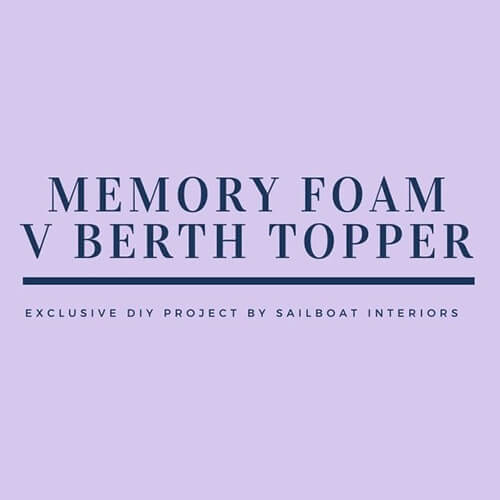The readers have spoken! You guys are loving our recent posts with various DIY projects, and this week’s project is sure to be a popular one – we’re talking about boat mattress memory foam toppers for your boat mattress.
Yes, memory foam toppers are quite the rage on sailboats. Just do a search on any sailboat forum and you’ll find threads about how a memory foam topper atop your normal v berth cushions will feel like a night at the Ritz.
That’s why we’re going to tell you how to make your own, because just as we mentioned in our Getting a Good Nights Sleep on a Boat blog post, products and projects that ensure you get a good night sleep on your boat are well worth the money spent.
Making a Memory Foam Topper for Your V Berth Boat Mattress
Here are two DIY examples of V Berths boat mattresses, based on a Catalina 30 V Berth and a Catalina 36 V Berth.
You’ll want to take a look at our “How To Measure Your V Berth” post first to orientate yourself with the key measurements we will be using for this boat DIY project.
Things to keep in mind
If your V Berth is less than 79″ at the Head (as with our Catalina 30 example), this project is very straightforward and easy.
If your V Berth is wider than 79″ at the Head (as with our Catalina 36 example) you will need to cut additional pieces of foam from those cut away from the foot end to add and glue to the head end.
This guide is also useful for smaller, rectangular-shaped berths, any odd-shaped berth, or cushions that you would like to upgrade in order to fit a memory foam topper on.
(Note:For odd shaped berths, please be careful when measuring, and take time to lay out your measurements and plan in a diagram first.)
Working with Memory Foam
Memory foam can be a challenge to work with due to its large size once it’s out of the shrink wrap. This requires a larger work area, so make sure you have plenty of space (inside your boat may not be the best or easiest place to work with it).
It can also be tricky to cut perfectly – however, even if your end product is not exactly perfect, once it’s covered with a beautiful sheet set and you get to sleep on it, both you and your back will be glad you did it, and you’ll forget all about any imperfect cuts.
For angled cuts like those on V Berths, we recommend keeping the foam depth to under 3″ to easily cut the foam. For a rectangular berth, you can just use an electric carving knife or foam cutter to make straight cuts to the memory foam.
You may also want to review The Boat Galley’s blog post “Sleeping Well Means Better Cruising” for other memory foam recommendations.
Boat Mattress Memory Foam Topper Materials Needed
- Memory Foam
- Tape Measure
- Large Flat Work Area (Garage, Outdoor Pavement Area)
- Tarp – to provide a clean surface. A large work bench or work table is the best option.)
- Plywood or Thin Board – To protect area under the foam when cutting
- Pen/Marker – To mark key measurements
- 2″ – 4″ Thick Board or 98″ Professional Cutting Guide with 2 C Clamps (See below for where to purchase) – To guide cutting and compress the foam.
- Utility Knife or 60mm Rotary Cutter – To cut the foam
- Work Gloves
- 3MM Adhesive (Optional) – Only needed if Head Width exceeds 79″ or for some odd-shaped projects
Example 1: 1980 Catalina 30
Measurements: 79″ Head, 75″ Total Length, 12″ Foot Width
(Head measurement smaller than 79″)
A V Berth of this size will only require the memory foam to be cut in two locations.
As shared in our How to Measure Your V Berth post, the important measurements will be the Head Width (HW), Foot Width (FW), and the Total Length of the V Berth.
The two key measurements to choosing memory foam is the Head Width (83.5″) and Total Length (71″). For this project we can use the King Memory Foam product by ExceptionalSheets which measures 75.5″ Wide x 79.5″ Long.
Using the 79.5 Long side as the Head of our V Berth we then only need to cut the memory foam on each side to make the proper V-shape for our mattress topper.
Step 1: Spread your tarp on a flat surface and lay out the memory foam.
Step 2: Measure several times to be sure which end will provide enough width for your top (Head side) and which end will provide enough length to be your Total Length.
Step 3: Mark the center of the Foam at both the top (Head side) and at the center of the bottom (Foot side).
Step 4: Next divide your Foot Width (FW) by 2.
In this example, divide 12″ (FW) by two to get 6″.
Step 5: Now, starting at your Foot side center mark, measure out 6″ on each side and mark the foam.
Step 6: Using a board or professional cutting guide, connect the top right (Head side) edge of the memory foam with the bottom right Foot measurement. Either mark where you will need to cut or proceed to cutting the memory foam.
Step 7: To cut, lay a piece of plywood or flat board under the memory foam where the cut will be made to protect the flat surface area from becoming cut into. Press the board or cutting guide down on top of the memory foam to reduce the thickness of the foam that will need to be cut. If you have the work area to use C-Clamps to do this that would be helpful. If not, you may need to ask a second person to help you and have them kneel on the board to keep pressure on the foam while you cut the foam. A 60mm rotary cutter is the preferred tool to make a continuous clean cut on the foam but a utility knife can be used as well.
Step 8: Connect the top left (Head side) edge of the memory foam with the bottom left edge of the Foot measurement. Repeat steps to cut the foam.
Example 2: 1995 Catalina 36 Mark II
Measurements: 81″ Head, 82″ Total Length, 17″ Foot Width
(Head measurement larger than 79″)
In this example the Head Width is greater than 79″. We will still only need one piece of memory foam. We will choose the CAL King Memory foam size by ExceptionalSheets that is 71.5 Wide x 83.5 Long. We will position the 71.5″ side as Head side and use the 83.5″ side to have our total length needed. The 71.5″ is well short of what we will need but we will be adding and gluing additional foam pieces to the right and left sides of the Head. An inch and a half could be trimmed from the total length but is not necessary where it will only amount to 3/4″ extra on each end of the foam.
Step 1: Mark the center of the Foam at both the top (Head side) and at the center of the bottom (Foot side).
Step 2: Next divide your Foot Width (FW) by 2.
Step 3: Now, starting at your Foot side center mark, measure out 6″ on each side and mark the foam.
Step 4: Use your board or professional measuring guide to determine where the Head width will need to measure to. This will be beyond where the foam ends. Place the board where you believe it needs to go. Our total Head Width (HW) is 81″. This
number divided in two is 40.5″. Using a tape measure, measure from the center of the Head side out 40.5″. The length of the memory foam on the Head side is 71.5″ and our Head Width is 81″ or 9.5 inches short. We will need an additional piece added to each end of the head that is 4.75″ in length.
Step 5: Cut the memory foam. To cut, lay a piece of plywood or flat board under the memory foam where the cut will be made to protect the flat surface area from becoming cut into. Press the board or cutting guide down on top of the memory foam to reduce the thickness of the foam that will need to be cut. If you have the work area to use C-Clamps to do this that would be helpful. If not, you may need to ask a second person to help you and have them kneel on the board to keep pressure on the foam while you cut the foam. A 60mm rotary cutter is the preferred tool to make a continuous clean cut on the foam but a utility knife can be used as well.
Step 6: Using the excess memory foam that was cut away, measure and cut to additional foam pieces that are 4.75″ in length. Tape them in place temporarily where the additional memory foam pieces are needed on the Head side. Using the board or professional cutting guide again, cut the additional foam so it matches with shape and angles of the V Berth needed.
Step 7: In a very well ventilated area, away from anything even remotely flammable, use the 3mm adhesive spray to adhere the two additional pieces to the memory foam. The memory foam will not be seen once a coverlet or sheet is on it so be generous with the adhesive so it fully covers both where the foam joins together on the inside surface and on the exterior creases. Do not move the memory foam for three days to let it dry and adhere as fully as possible. Check how well the extra pieces have adhered and add additional spray if not fully satisfied.
Ready to make this for your boat? These open cell foam memory foam toppers are perfect to use. And the best part? They are Made in the USA! We recommend adding one of our CinchFit Boat Mattress Pads over the memory foam topper for the perfect level of comfort for nights on the water!
Now that you have your Boat Mattress Topper, you're ready for Boat Sheets & Boat Bedding to make your Master and Guest Berths perfect! Visit our store at Quahog Bay Bedding Here to see our complete selection of boat bedding products!
Below is a sneak peak of a few of our boat bedding products!





